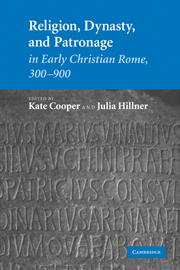Introduction
Published online by Cambridge University Press: 02 October 2009
Summary
‘In all ages, whatever the form or name of government, be it monarchy, republic, or democracy, an oligarchy lurks behind the façade.’ With these words Sir Ronald Syme began his landmark investigation into the lively political networks of the late Republican noble families of the city of Rome, families who drew their power from ancestry and landed wealth as much as from the political process. This statement holds gradually less true for their successors at the end of antiquity, who struggled to maintain their position in the face of set-backs such as civil war in Italy in the 470s and 480s, and again from 534 to 554. The fifth and sixth centuries saw a progressive erosion of the landed wealth of Rome's aristocratic families. While they had long resisted the centralizing instincts of Rome's principal land-owner, the emperor, new pressures and opportunities led the Roman aristocracy to seek a more cooperative relationship with Rome's bishop, whose ever greater ex officio holdings came to rival those of the emperor, and were more secure in the face of political upheaval. If this strategy of cooperation was largely successful, however, its success brought with it the eventual waning of Roman memory where the aristocracy was concerned.
During late antiquity, the urban fabric of the city of Rome was the result of efforts by three categories of patron: senators, emperors, and bishops (although individual patrons could belong to more than one category).
- Type
- Chapter
- Information
- Publisher: Cambridge University PressPrint publication year: 2007
- 2
- Cited by



